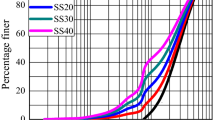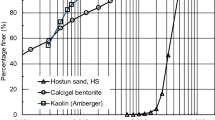Abstract
Literature regarding the pore pressure generation characteristics and in turn the cyclic resistance behaviour of silty sand deposits is confusing. In an attempt to clarify the effect of nonplastic fines on undrained cyclic pore pressure response of sand–silt mixtures, an experimental programme utilising around 289 stress-controlled cyclic triaxial tests on specimens of size 50 mm diameter and 100 mm height was carried out at a frequency of 0.1 Hz. Specimens were prepared to various measures of density through constant gross void ratio approach, constant relative density approach, constant sand skeleton void ratio approach, and constant interfine void ratio approach to study the effect of nonplastic fines on pore pressure response of sand–silt mixtures. The effect of relative density, confining pressure as well as the frequency and magnitude of cyclic loading was also studied. It was observed that the pore pressure response is greatly influenced by the limiting silt content and the relative density of a specimen corresponding to any approach. The influence of other parameters such as relative density, confining pressure and magnitude of cyclic loading was as usual but an increase in frequency of cyclic loading was seen to generate excess pore pressure at a higher rate indicating an impact load type of behaviour at higher frequency. Utilising the entire test results over a wide range of parameters a new pore pressure band for sand–silt mixtures in line with Lee and Albaisa (1974) has been proposed. Similarly another pore pressure band corresponding to 10th cycle of loading as suggested by Dobry (1985) and up to a shear strain of around 25% has been proposed. These two bands can readily be used by researchers and field engineers to readily assess the pore pressure response of sand–silt mixtures.

























Similar content being viewed by others
References
American Society for Tests and Materials (ASTM) (1996) Standard test method for load controlled cyclic triaxial strength of soil. ASTM D 5311-92 (Re-approved 1996). ASTM, West Conshohoken
Amini F, Qi GZ (2000) Liquefaction testing of stratified silty sands. J Geotech Geoenviron Eng 126(3):208–217. doi:10.1061/(ASCE)1090-0241(2000)126:3(208)
Chang NY, Yeh ST, Kaufman LP (1982) Liquefaction potential of clean and silty sands. Proceedings of 3rd international conference on earthquake microzonation, vol 2, pp 1017–1032
Derakhshandi M, Rathje EM, Hazirbaba K, Mirhosseini SM (2007) The effect of plastic fines on the pore pressure generation characteristics of saturated sands. Soil Dyn Earthq Engi. www.elseiver.com. doi: 10.1016:1-11
Dobry R (1985) Liquefaction of soils during earthquakes. Committeee on earthquake engineering, commission on engineering and technical systems, national research council. National Academy Press, Washington
Dobry R, Ladd RS, Chang RM, Powell D (1982) Prediction of pore water pressure build up and liquefaction of sands during earthquakes by the cyclic strain method. NBS Building Sci Ser Wash DC 138:1–150
Erten D, Maher MH (1995) Cyclic undrained behaviour of silty sand. Soil Dyn Earthq Eng 14:115–123. doi:10.1016/0267-7261(94)00035-F
Finn WDL, Ledbetter RH, Wu G (1994) Liquefaction in silty soils: design and analysis. Ground failures under seismic conditions, geotechnical special publication. ASCE 44:51–74
Govindaraju L (2005) Liquefaction and dynamic properties of sandy soils. Ph.D thesis submitted to Indian Institute of Science, Bangalore in the Faculty of Engineering
Hazirbaba K (2005) Pore pressure generation characteristics of sands and silty sands: a strain approach. Dissertation presented for Ph.D program to the faculty of Graduate School, University of Texas, Austin
IS (1992) 1498-1970 Classification and identification of soils
IS (1992) 2720 (Part 3) Sect. 1-1980. Specific gravity-fine grained soils; Sect. 2-1980. Specific gravity—fine, medium and coarse grained soils
IS (1995) 2720 (Part 4)-1985. Grain size analysis
IS (1983) 2720 (Part 14). Determination of density index (relative density) of cohesionless soils
Kenny TC (1977) Residual strength of mineral mixtures. Proceedings of the 9th international conference on soil mechanics and foundation engineering, Tokyo 1:155–160
Kuerbis R, Negussey D, Vaid YP (1988) Effect of gradation and fines content on the undrained response of sand. Proceedings on hydraulic fill structures, geotechnical special publication. ASCE 21:330–345
Lee KL, Albaisa A (1974) Earthquake induced settlements in saturated sands. J Geotech Eng Div 100(GT4):387–406
Martin GR, Finn LD, Seed HB (1975) Fundamentals of liquefaction during cyclic loading. J Geotech Eng Div 101(GT5):423–438
Polito CP (1999) The effects of non-plastic and plastic fines on the liquefaction of sandy soils. Ph.D. dissertation, Virginia Polytechnic Institute and State University, pp 1–274
Polito CP, Martin II Jr (2001) Effects of nonplastic fines on the liquefaction resistance of sands. J Geotech Geoenviron Eng 127(5):408–415. doi:10.1061/(ASCE)1090-0241(2001)127:5(408)
Ravishankar BV (2006) Cyclic and monotonic undrained behavior of sandy soils. PhD thesis submitted to Indian Institute of Science, Bangalore in the Faculty of Engineering
Sadek S, Saleh M (2007) The effect of carbonaceous fines on the cyclic resistance of poorly graded sands. J Geotech Geol Eng 25:257–264. doi:10.1007/s10706-006-9108-1
Seed HB, Tokimatsu K, Harder LF, Chung R (1985) Influence of SPT procedures in soil liquefaction resistance evaluations. J Geotech Eng 111(12):861–878
Shen CK, Vrymoed JL, Uyeno CK (1977) The effects of fines on liquefaction of sands. Proceedings of the 9th international conference on soil mechanics and foundation engineering, Tokyo, Japan, vol 2, pp 381–385
Silver ML, Seed HB (1971) Volume changes in sands during cyclic loading. J Soil Mech Found Div ASCE 97(SM 9):1171–1185
Singh S (1994) Liquefaction characteristics of silts. Ground failure under seismic conditions, geotechnical special publication. ASCE 44:105–116
Thevanayagam S (2000) Liquefaction potential and undrained fragility of silty soils. Proceedings of 12th world conference on earthquake engineering, Auckland
Ueng TS, Sun CW, Chen CW (2004) Definition of fines and liquefaction resistance of Maoluo river soil. Soil Dyn Earthq Eng 24:745–775. doi:10.1016/j.soildyn.2004.06.011
Vaid YP (1994) Liquefaction of silty soils. Ground failure under seismic conditions, geotechnical special publication. ASCE 44:1–16
Wang JN, Kavazanjian E (1989) Pore pressure development during non-uniform cyclic loading. Soil Found 29(2):1–14
Xenaki VC, Athanasopoulos GA (2003) Liquefaction resistance of sand–silt mixtures: an experimental investigation of the effect of fines. Soil Dyn Earthq Eng 23:183–194. doi:10.1016/S0267-7261(02)00210-5
Acknowledgments
The work reported in this technical paper was carried out with the sponsorship from Ministry of Earth Sciences and formerly Department of Science and Technology (Seismology Division), Ministry of Science and Technology, Government of India. The authors express their sincere appreciation to the ministry.
Author information
Authors and Affiliations
Corresponding author
Rights and permissions
About this article
Cite this article
Dash, H.K., Sitharam, T.G. Undrained Cyclic Pore Pressure Response of Sand–Silt Mixtures: Effect of Nonplastic Fines and Other Parameters. Geotech Geol Eng 27, 501–517 (2009). https://doi.org/10.1007/s10706-009-9252-5
Received:
Accepted:
Published:
Issue Date:
DOI: https://doi.org/10.1007/s10706-009-9252-5




